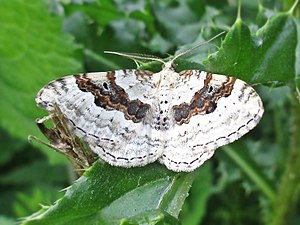Black-brown banded leaf tensioner
| Black-brown banded leaf tensioner | ||||||||||||
|---|---|---|---|---|---|---|---|---|---|---|---|---|

Black- brown banded leaf tensioner ( Xanthorhoe montanata ), male |
||||||||||||
| Systematics | ||||||||||||
|
||||||||||||
| Scientific name | ||||||||||||
| Xanthorhoe montanata | ||||||||||||
| ( Denis & Schiffermüller , 1775) |
The black- brown banded leaf tensioner ( Xanthorhoe montanata ), also known as the mountain forest leaf tensioner , is a butterfly ( moth ) from the family of the tensioners (Geometridae). The specific epithet is based on the Latin word montanus meaning "mountain dwellers". However, this name is misleading because the species occurs predominantly in the plain.
features
butterfly
The moths reach a wingspan of 23 to 31 millimeters. The upper side of the forewing is milky white, the black-brown central field is constricted over the inner edge and in the middle and forks under the front edge into two narrow transverse bands in the middle of which a black discoidal spot stands out on a light background. The fringing area is colored pale gray. The moths vary greatly in their drawing, so there are almost no-drawing whitish specimens or animals with a very wide black-brown central band. The whitish upper side of the hind wings is traversed by a few thin, dark transverse lines that faintly shine through to the lower side. The antennae of the males are serrated, those of the females are thread-shaped.
Caterpillar
Adult caterpillars are smooth and slender. They are colored ocher or yellow-gray and show a dark brown topline, which is expanded to diamond spots on the middle segments. The side lines are dark gray.
Similar species
The black-eye- tongues ( Cosmorhoe ocellata ) as well as the garden-tongues ( Xanthorhoe fluctuata ) both differ in the absence of the bifurcation of the middle field as well as a clear black root field on the upper side of the forewing .
Distribution and occurrence
The species occurs from the Iberian Peninsula across Western and Central Europe including the British Isles to the Urals and Siberia . In the north, the area extends beyond the Arctic Circle . On the Shetland and Faroe Islands it is represented by the subspecies Xanthorhoe montanata shetlandica , in Fennoscandinavia by Xanthorhoe montanata lapponica . In the south the area extends from the islands of the western Mediterranean to the Balkan Peninsula and further over Asia Minor to western Central Asia.
The black-brown banded leaf tensioner colonizes a variety of different habitats and occurs, for example, in damp forests, moorland and bank areas, on embankments or on grassy meadows and heather areas as well as in gardens.
Way of life
The moths are active during the day and at night, visit artificial light sources and can sometimes be found on street lamps or illuminated window panes. To eat, they suckle on flowers, bait or excrement. They fly in one generation from May to July. In the resting position, they like to sit head down or at an angle with triangular wings on tree trunks, house walls, under leaves or in the herbaceous layer. The caterpillars live from the beginning of August, overwinter and pupate in April or May of the following year. They feed preferred by low plants, these include dock - ( Rumex ), Rubus - Primrose ( Primula ), plantain ( Plantago ), Labkraut- ( Galium ), Nelkenwurz- ( Geum ) and blueberry species ( Vaccinium ).
Danger
The black-brown banded leaf tensioner is usually found in large numbers in the individual federal states in Germany and is classified as “not endangered” on the red list of endangered species .
Individual evidence
- ^ Arnold Spuler: The butterflies of Europe , Volume 2, E. Schweizerbart'sche Verlagsbuchhandlung, Stuttgart, 1910, p. 47
- ^ Axel Hausmann, Jaan Viidalepp: The Geometrid Moths of Europe . In: Axel Hausmann (Ed.): The Geometrid Moths of Europe . 1st edition. Volume 3: Larentiinae II . Apollo Books, Stenstrup 2012, ISBN 978-87-88757-39-2 (English). , Pp. 114-116
- ↑ a b Günter Ebert (Ed.): The butterflies of Baden-Württemberg Volume 8, Nachtfalter VI (Spanner (Geometridae) 1st part), Ulmer Verlag Stuttgart 2001. ISBN 3-800-13497-7 , pp. 257-259
- ↑ Endangerment
literature
- Axel Hausmann, Jaan Viidalepp: The Geometrid Moths of Europe . In: Axel Hausmann (Ed.): The Geometrid Moths of Europe . 1st edition. Volume 3: Larentiinae II . Apollo Books, Stenstrup 2012, ISBN 978-87-88757-39-2 (English).
- Walter Forster , Theodor A. Wohlfahrt : The butterflies of Central Europe. Volume 5: Spanner. (Geometridae). Franckh'sche Verlagshandlung, Stuttgart 1981, ISBN 3-440-04951-5 .
- Günter Ebert (Hrsg.): The butterflies of Baden-Württemberg Volume 8, Nachtfalter VI (Spanner (Geometridae) 1st part), Ulmer Verlag Stuttgart 2001. ISBN 3-800-13497-7
- Manfred Koch , Wolfgang Heinicke, Bernd Müller: We determine butterflies. Volume 4: Spanner. 2nd, improved and enlarged edition. Neumann, Leipzig / Radebeul 1976, DNB 780451570 .
- Arno Bergmann: The large butterflies of Central Germany. Volume 5/1: Spanner. Distribution, forms and communities. Urania-Verlag, Jena 1955, DNB 450378403 .
Web links
- Lepiforum e. V. - Taxonomy and photos
- euroleps.ch - Imago, egg, caterpillar, doll
- pyrgus.de - Butterflies and their ecology
- kolumbus.fi - caterpillar
- ukmoths.org.uk - UKMoths

